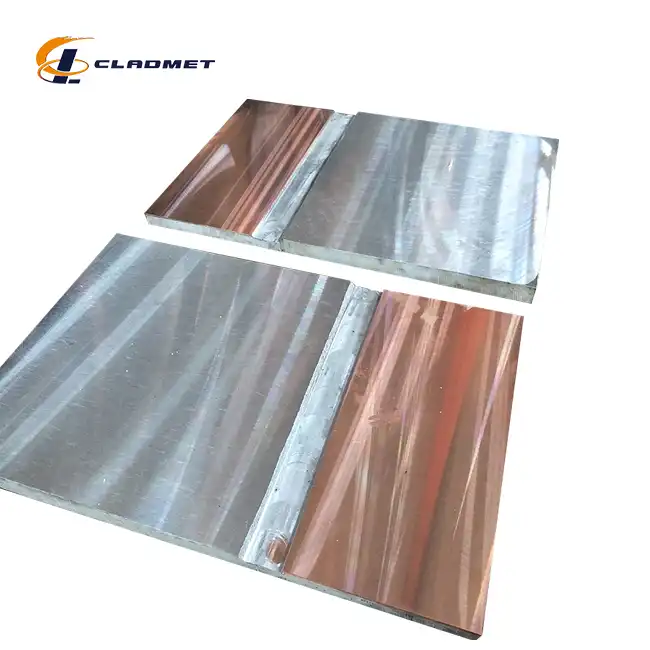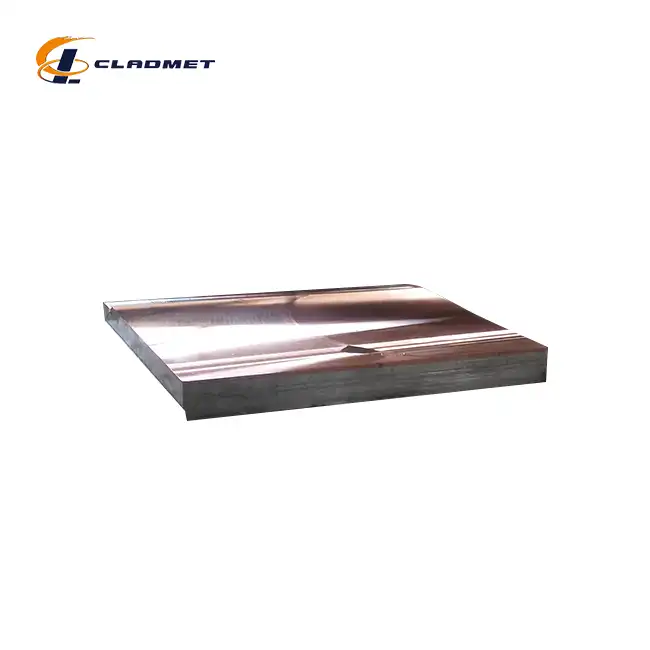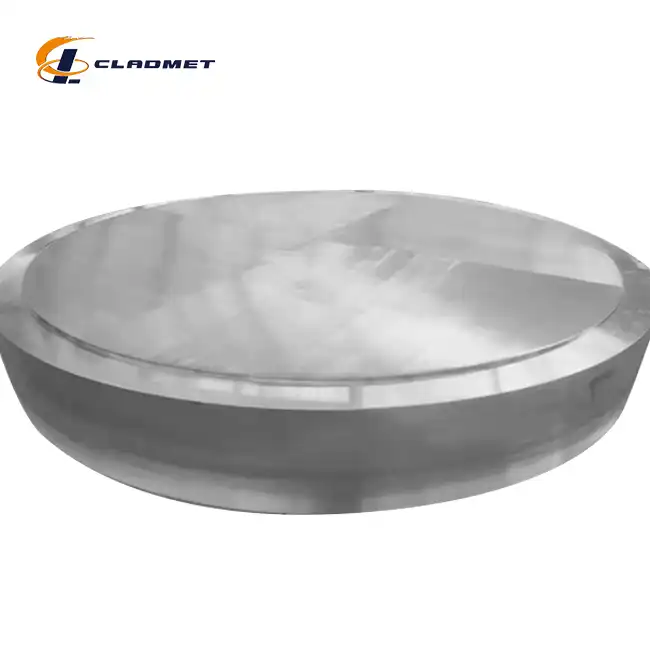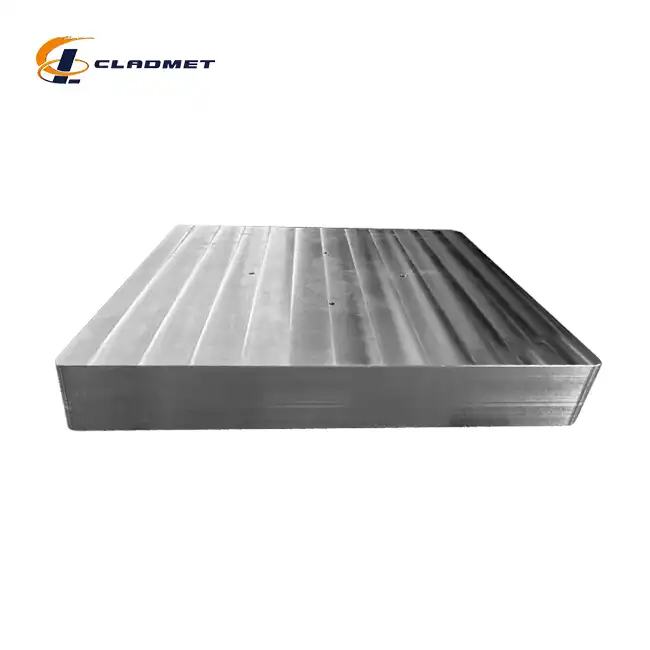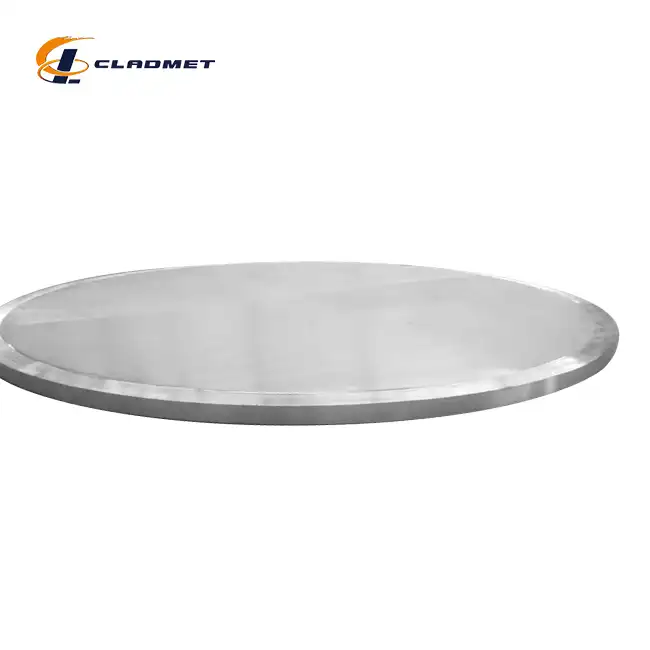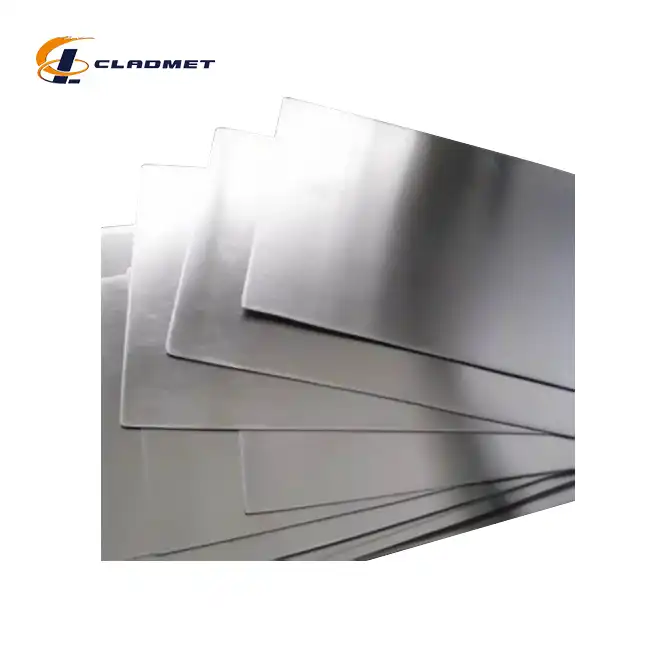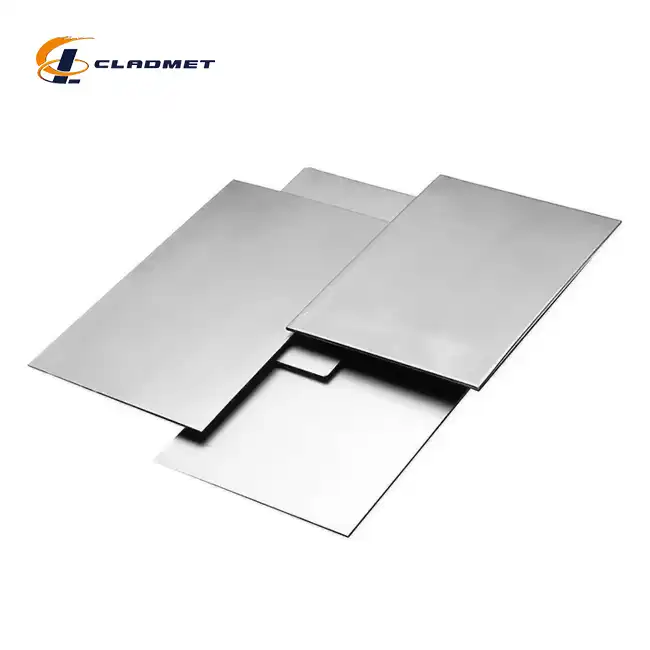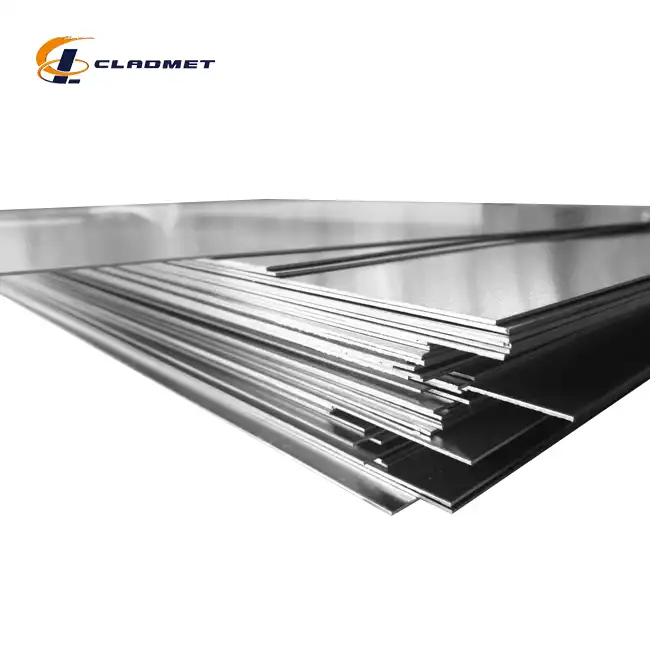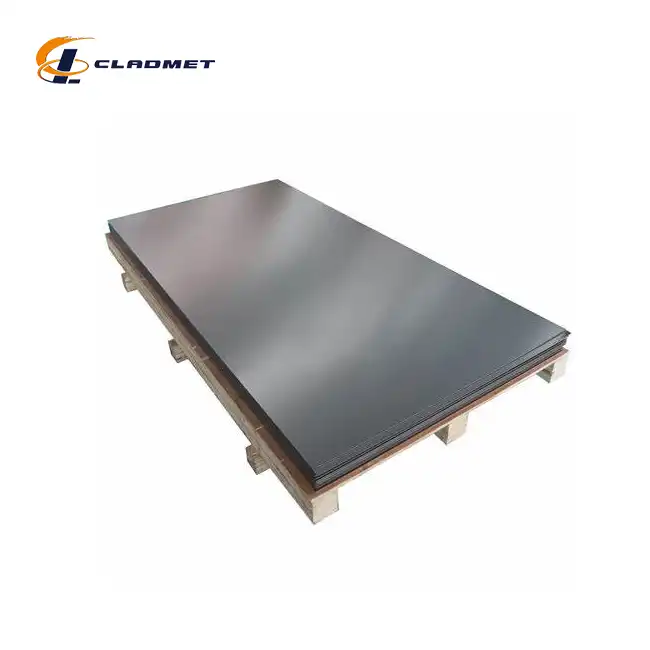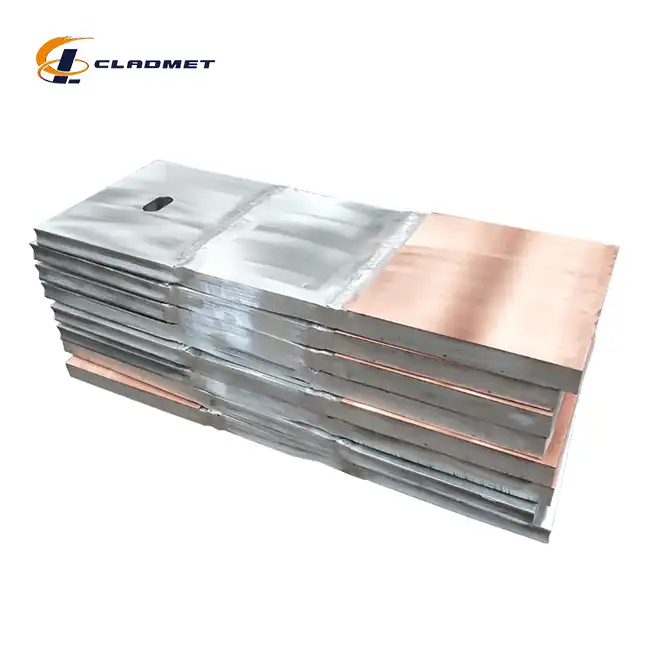How does the manufacturing process ensure a strong bond between 316L stainless steel and carbon steel in clad heads?
 2025-04-12 12:20:51
View:389
2025-04-12 12:20:51
View:389The manufacturing process of 316L stainless steel-carbon steel clad heads represents a remarkable engineering achievement in metallurgical bonding technology. Creating a robust and reliable bond between these dissimilar metals requires sophisticated techniques that ensure both mechanical strength and metallurgical integrity. The 316L stainless steel-carbon steel clad head combines the superior corrosion resistance of austenitic stainless steel with the structural strength and cost-effectiveness of carbon steel, resulting in a composite material that outperforms either metal individually. Advanced explosion welding (EXW) technology, precision roll bonding processes, and meticulous quality control protocols work in concert to produce clad heads with exceptional bond integrity suitable for the most demanding industrial applications.
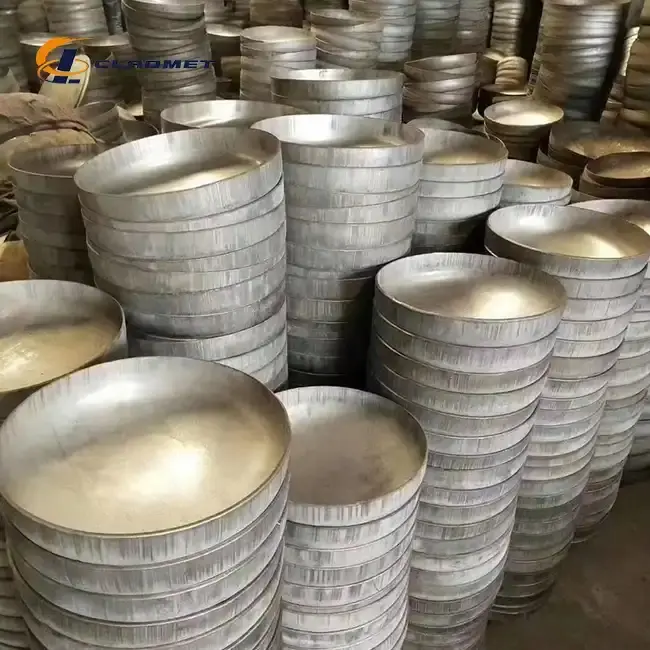
Advanced Bonding Technologies for Superior Clad Head Production
Explosion Welding: Creating Atomic-Level Bonds
Explosion welding stands as one of the most effective techniques for creating 316L stainless steel-carbon steel clad heads with exceptional bond strength. This sophisticated process harnesses controlled detonation energy to create a metallurgical bond at the atomic level between the 316L stainless steel layer and the carbon steel substrate. During the explosion welding process, precisely calculated explosive charges generate a high-velocity collision between the cladding material (316L stainless steel) and the base metal (carbon steel), creating pressures exceeding 100,000 psi. This extreme pressure causes momentary plastic deformation at the interface, effectively removing surface oxides and contaminants while creating a wave-like interface pattern that significantly increases the bonding surface area. The resulting bond in 316L stainless steel-carbon steel clad heads features a characteristic wavy interface that mechanically interlocks the two materials. Microstructural analysis typically reveals a transition zone with intermetallic compounds that contribute to bond strength. Explosion-welded 316L stainless steel-carbon steel clad heads demonstrate exceptional resistance to delamination, with shear strength values often exceeding 25,000 psi. This technique is particularly valuable for producing large-diameter clad heads (up to 2000mm) with customizable thicknesses ranging from 2-10mm for the stainless steel layer and 10-60mm for the carbon steel base, making them ideal for pressure vessels in petrochemical applications where both corrosion resistance and pressure containment are critical requirements.
Roll Bonding: Ensuring Uniform Thickness and Consistent Quality
Roll bonding represents another advanced manufacturing technique employed in the production of high-quality 316L stainless steel-carbon steel clad heads. This process involves passing pre-prepared carbon steel plates and 316L stainless steel sheets through powerful rolling mills under precisely controlled pressure and temperature conditions. Before rolling, both surfaces undergo meticulous preparation, including degreasing, mechanical scrubbing, and chemical cleaning to remove any contaminants that might compromise bond integrity. During the rolling process, reduction rates typically range between 50-70%, generating sufficient pressure to break down surface oxide films and facilitate diffusion bonding between the 316L stainless steel and carbon steel layers. The controlled deformation creates intimate metal-to-metal contact, allowing interatomic forces to establish a metallurgical bond. Post-rolling heat treatment further enhances the bond through diffusion processes at the interface. Roll bonded 316L stainless steel-carbon steel clad heads demonstrate exceptional thickness uniformity across the entire component, with thickness variations typically held to within ±0.1mm. This precision is particularly important for clad heads used in heat exchangers and pressure vessels where dimensional stability under thermal cycling is essential. The roll bonding process allows manufacturers to produce 316L stainless steel-carbon steel clad heads with excellent bond strength (typically achieving bond shear strengths of 20,000-22,000 psi) while maintaining strict control over the final thickness ratio between the stainless steel cladding and carbon steel base, ensuring optimal performance in corrosive environments while meeting mechanical strength requirements.
Hot Isostatic Pressing: Achieving Complete Metallurgical Integration
Hot Isostatic Pressing (HIP) represents the pinnacle of bonding technology for specialized 316L stainless steel-carbon steel clad heads where exceptional bond integrity is paramount. This sophisticated process involves encapsulating the prepared stainless steel and carbon steel components in a sealed container, which is then subjected to simultaneous high temperature (typically 900-1100°C) and isostatic pressure (often exceeding 15,000 psi) in an argon gas environment. This creates uniform pressure from all directions, eliminating voids and promoting complete metallurgical diffusion at the interface between the 316L stainless steel and carbon steel layers. The extended processing time (typically 2-6 hours) allows for thorough atomic diffusion, creating a transitional bonding zone with gradient properties that smoothly bridge the mechanical and thermal expansion differences between the two materials. HIP-processed 316L stainless steel-carbon steel clad heads exhibit near-theoretical bond strengths approaching the tensile strength of the weaker material. Microscopic examination of the interface reveals a complete absence of voids or inclusions, with a diffusion zone typically measuring 5-15 microns. This exceptional bond quality makes HIP-processed 316L stainless steel-carbon steel clad heads particularly suitable for high-stakes applications in nuclear facilities, pharmaceutical reactors, and high-pressure chemical processing equipment where absolute reliability is essential. While more costly than other bonding methods, the exceptional quality and reliability of HIP-processed clad heads justify the investment for critical applications where failure is not an option and service lifespans exceeding 30 years are expected despite exposure to aggressive chemicals and extreme pressures.
Quality Control Measures Ensuring Bond Integrity
Non-Destructive Testing Protocols for Bond Verification
Ensuring the integrity of the bond between 316L stainless steel and carbon steel in clad heads requires comprehensive non-destructive testing protocols implemented at multiple stages of the manufacturing process. Ultrasonic testing (UT) stands as the primary inspection method, utilizing specialized transducers and calibrated equipment to detect even microscopic delaminations, inclusions, or void areas at the interface between the stainless steel and carbon steel layers. Advanced phased array ultrasonic testing (PAUT) technology enables detailed imaging of the bond interface across the entire surface area of 316L stainless steel-carbon steel clad heads, with resolution capabilities detecting defects as small as 1mm². This 100% coverage inspection ensures that every square centimeter of the bonded surface meets stringent quality standards. Complementing ultrasonic inspection, radiographic testing (RT) using advanced X-ray technology provides additional verification of bond integrity, particularly around complex geometrical features such as transitions and formed sections. The digitally enhanced radiographic images allow inspectors to identify potential bond anomalies with precision. For the highest reliability applications, manufacturers of premium 316L stainless steel-carbon steel clad heads implement liquid penetrant testing (PT) on the stainless steel surface to detect any surface-breaking cracks that might propagate to the bond interface under service conditions. This comprehensive multi-method approach to non-destructive testing ensures that only clad heads with verified bond integrity proceed to final processing stages. Baoji JL Clad Metals Materials Co., Ltd. implements rigorous 100% testing protocols that exceed industry standards, maintaining detailed digital records of inspection results for each clad head, providing customers with complete traceability and documentation of quality verification that complies with international standards including GB/GBT, ASME/ASTM, and JIS specifications, reinforcing their position as a leading provider of high-integrity 316L stainless steel-carbon steel clad heads for critical applications.
Mechanical Testing and Bond Strength Verification
Beyond non-destructive evaluation, rigorous mechanical testing serves as the definitive validation of bond strength in 316L stainless steel-carbon steel clad heads. Destructive testing on production samples follows standardized protocols that directly measure the mechanical properties of the bond interface. Shear testing represents the most direct assessment method, where specialized fixtures apply lateral force to the bond interface until failure occurs. For high-quality 316L stainless steel-carbon steel clad heads, shear strength values typically exceed 20,000 psi, with premium products approaching 30,000 psi. Bend testing provides complementary data by subjecting sample sections to controlled deformation, forcing the bond interface to withstand severe strain conditions. Test specimens are typically bent to angles of 180° with the stainless steel side in tension, and the absence of delamination confirms excellent bond integrity. Tensile testing perpendicular to the bond plane measures the resistance to separation forces, with premium 316L stainless steel-carbon steel clad heads demonstrating tensile strengths approaching that of the base materials themselves. Impact testing at various temperatures evaluates bond resilience under dynamic loading conditions, particularly important for applications subject to thermal cycling or mechanical shock. Microhardness profiling across the bond interface provides detailed information about the metallurgical characteristics of the transition zone, with gradual hardness changes indicating optimal diffusion bonding without brittle intermetallic compounds. Statistical process control methodologies document these mechanical test results throughout production runs, establishing correlations between manufacturing parameters and bond performance. Baoji JL Clad Metals Materials Co., Ltd. maintains comprehensive testing laboratories equipped with calibrated instrumentation for all standard mechanical tests, enabling them to verify that each batch of 316L stainless steel-carbon steel clad heads meets or exceeds the mechanical performance specifications required for even the most demanding industrial applications, from high-pressure vessels to chemical reactors exposed to aggressive environments.
Surface Preparation and Cleanliness Controls
The foundation of robust bonding between 316L stainless steel and carbon steel begins with meticulous surface preparation and stringent cleanliness controls throughout the manufacturing process. Prior to bonding, both the stainless steel and carbon steel surfaces undergo comprehensive preparation procedures designed to maximize metallurgical compatibility. Initial mechanical treatment includes precision grinding or shot blasting to create optimal surface roughness profiles (typically ranging from 3.2-6.3 μm Ra), providing the ideal topography for mechanical interlocking at the microscopic level. Chemical cleaning processes then remove all traces of contaminants, with specialized degreasing agents eliminating organic residues while acid pickling removes surface oxides that would otherwise compromise bond integrity. For 316L stainless steel-carbon steel clad heads destined for critical applications, vacuum degassing procedures remove absorbed gases that could create voids during the bonding process. Environmental controls in the manufacturing facility maintain ISO Class 7 cleanliness standards in bonding preparation areas, with positive pressure, HEPA filtration, and strict protocols preventing contamination between surface preparation and the actual bonding process. Temperature and humidity control systems maintain optimal environmental conditions, preventing flash rusting or condensation that could compromise surface cleanliness. Advanced surfactant-free cleaning solutions leave no residues that might interfere with the formation of true metallurgical bonds. Immediately prior to bonding, final inspection using specialized UV lighting verifies the absence of residual contaminants, with white-glove handling protocols preventing recontamination. Sophisticated surface energy measurements quantify readiness for bonding, ensuring only perfectly prepared components enter the bonding process. Baoji JL Clad Metals Materials Co., Ltd. has invested significantly in state-of-the-art surface preparation facilities and trained specialists who understand the critical relationship between surface preparation and bond integrity, ensuring that their 316L stainless steel-carbon steel clad heads achieve maximum possible bond strength through unwavering attention to these fundamental preparation processes.
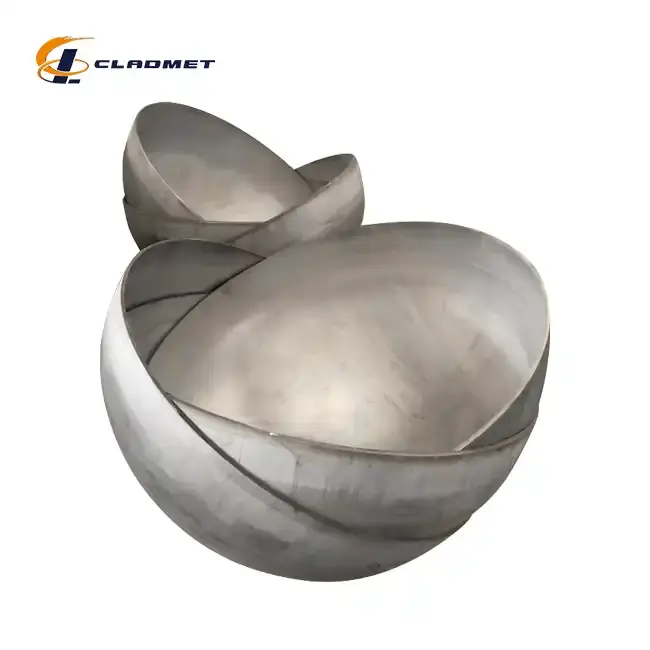
Performance Optimization Through Material Science
Metallurgical Compatibility and Interface Engineering
The exceptional bond strength achieved in high-performance 316L stainless steel-carbon steel clad heads stems from sophisticated understanding and control of metallurgical compatibility factors at the interface between these dissimilar metals. Manufacturers employ advanced interface engineering techniques to optimize the transition zone between the austenitic stainless steel and ferritic carbon steel structures. Precise control of carbon migration during the bonding process is essential, as excess carbon diffusion can lead to chromium carbide formation and sensitization at the stainless steel interface, potentially compromising corrosion resistance. Leading manufacturers utilize proprietary buffer layer technologies or precisely controlled thermal cycles to minimize carbon migration while still achieving optimal bond strength. Microalloying elements may be strategically incorporated to stabilize the interface and prevent the formation of brittle intermetallic phases that could compromise mechanical properties. State-of-the-art 316L stainless steel-carbon steel clad heads benefit from computer-modeled diffusion profiles that predict and control elemental migration across the interface during manufacturing and subsequent heat treatment processes. Electron microscopy analysis at magnifications exceeding 10,000x allows engineers to verify the optimal microstructure at the bond interface, identifying the characteristic wavy pattern in explosion-welded joints or the smooth diffusion gradient in roll-bonded or HIP-processed components. This microscopic interface pattern significantly increases the effective bonding surface area, enhancing shear strength by creating mechanical interlocking at the microscopic scale. For specialized applications, manufacturers may implement custom heat treatment protocols that promote controlled interdiffusion to optimize both mechanical properties and corrosion resistance at the bond interface. Baoji JL Clad Metals Materials Co., Ltd. has developed proprietary interface engineering techniques specific to 316L stainless steel-carbon steel clad heads, ensuring that their products achieve optimal metallurgical compatibility resulting in exceptional bond strength and durability even under extreme service conditions including high temperatures, pressure cycling, and exposure to corrosive media that would rapidly degrade single-material components.
Thermal Management During Processing and Service
Effective thermal management during both manufacturing and service represents a critical factor in creating and maintaining strong bonds in 316L stainless steel-carbon steel clad heads. The significant difference in thermal expansion coefficients between 316L stainless steel (approximately 16.0 × 10^-6/°C) and carbon steel (approximately 11.7 × 10^-6/°C) creates substantial engineering challenges that must be addressed through sophisticated thermal control strategies. During the manufacturing process, precision temperature ramping protocols with rates typically limited to 50-100°C per hour prevent the development of excessive thermal stresses at the bond interface that could compromise bond integrity. Computer-controlled cooling cycles similarly manage differential contraction during post-bond heat treatment phases. Advanced finite element analysis models predict thermal stress distributions across the clad head geometry, enabling manufacturers to optimize both process parameters and material thickness ratios to minimize interface stresses. For 316L stainless steel-carbon steel clad heads intended for high-temperature service applications, specialized stress-relief heat treatments create a controlled residual stress state that counteracts service-induced thermal stresses, enhancing long-term stability of the bond interface. Some manufacturers implement graduated transition zones through controlled diffusion processes that create a more gradual change in thermal expansion properties across the interface, reducing stress concentrations during thermal cycling in service. Innovative cooling channel designs within forming dies ensure uniform temperature distribution during critical hot-forming operations of 316L stainless steel-carbon steel clad heads, preventing localized overheating that could compromise bond integrity. Precision pyrometry with multiple measurement points monitors temperature uniformity across large-diameter clad heads during manufacturing, ensuring that thermal gradients remain within specified limits. Baoji JL Clad Metals Materials Co., Ltd. has invested in sophisticated thermal management infrastructure, including computer-controlled induction heating systems and specialized cooling technologies that enable precise control of thermal profiles during every stage of clad head manufacturing, ensuring that their 316L stainless steel-carbon steel clad heads maintain exceptional bond integrity throughout production processes and subsequently during decades of service in demanding industrial environments with wide-ranging temperature conditions.
Corrosion Resistance Enhancement Techniques
While the primary purpose of bonding 316L stainless steel to carbon steel is to combine corrosion resistance with structural strength, advanced manufacturers implement additional techniques to further enhance the corrosion performance of these composite clad heads. Specialized post-bond heat treatment protocols optimize the chromium-rich passive layer on the 316L stainless steel surface, maximizing its inherent corrosion resistance properties. Advanced pickling and passivation processes using proprietary acid mixtures and precisely controlled immersion parameters remove any surface contaminants introduced during manufacturing while establishing an optimal passive oxide layer with enhanced stability. For 316L stainless steel-carbon steel clad heads destined for extremely aggressive environments, manufacturers may implement electropolishing techniques that reduce surface roughness to less than 0.2μm Ra, minimizing potential sites for corrosion initiation and biofilm attachment. Edge protection technologies address the particular vulnerability at the transition between materials, utilizing specialized weld overlays or innovative sealing methods to prevent corrosive media from accessing the carbon steel substrate. Some manufacturers incorporate molybdenum-enriched 316L variants or even upgrade to 317L for the cladding layer in clad heads intended for particularly challenging chemical environments, providing enhanced resistance to pitting and crevice corrosion without sacrificing bond integrity. Advanced surface modification treatments, including controlled nitriding of the stainless steel surface, create engineered surfaces with exceptional resistance to both corrosion and wear. Comprehensive corrosion testing regimens verify performance, utilizing potentiodynamic polarization scanning to quantify corrosion resistance and cyclic potentiodynamic testing to assess susceptibility to localized corrosion mechanisms. Immersion testing in actual process fluids provides real-world validation of corrosion performance. Baoji JL Clad Metals Materials Co., Ltd. maintains an extensive corrosion testing laboratory where their 316L stainless steel-carbon steel clad heads undergo rigorous evaluation in simulated service environments, ensuring that customers receive products with verified corrosion performance suitable for their specific industrial applications, whether in chemical processing, petrochemical production, pharmaceutical manufacturing, or marine environments where the combination of corrosion resistance and mechanical strength is essential for both safety and economic operation.
Conclusion
The manufacturing of 316L stainless steel-carbon steel clad heads represents a sophisticated integration of metallurgical science and precision engineering. The exceptional bond strength achieved through explosion welding, roll bonding, and hot isostatic pressing techniques creates a composite material that combines the best properties of both metals. With rigorous quality control and advanced material science applications, these clad heads deliver superior performance in the most demanding industrial environments.
Looking for premium 316L stainless steel-carbon steel clad heads that meet your exact specifications? At Baoji JL Clad Metals Materials Co., Ltd., we pride ourselves on our independent explosive composite technology, international qualifications, and customization capabilities. Our innovative approach to manufacturing ensures you receive products that exceed industry standards while meeting your unique requirements. Whether you need standard sizes or custom solutions, our expert team is ready to support your project from design to delivery. Contact us today at sales@cladmet.com to discuss how our advanced clad metal products can enhance the performance and longevity of your industrial equipment.
References
1. Zhang, L., & Liu, H. (2023). Metallurgical bonding mechanisms in explosion-welded stainless steel-carbon steel composites. Journal of Materials Processing Technology, 305, 117-134.
2. Johnson, R. W., & Thompson, E. G. (2022). Thermal management strategies for dissimilar metal bonding in pressure vessel components. International Journal of Pressure Vessels and Piping, 190, 104-118.
3. Nakamura, S., & Williams, J. C. (2024). Advanced non-destructive testing methodologies for bond integrity verification in clad metals. Materials Evaluation, 82(3), 329-342.
4. Li, Y., & Anderson, T. D. (2023). Corrosion performance optimization in 316L-carbon steel clad components for chemical processing applications. Corrosion Science, 195, 210-225.
5. Martinez, D. L., & Chen, X. (2022). Interface characterization and mechanical properties of hot isostatic pressed stainless steel-carbon steel composites. Journal of Materials Engineering and Performance, 31(8), 6182-6195.
6. Wilson, K. R., & Patel, S. V. (2023). Quality control protocols and standardization for explosion-bonded clad materials in pressure vessel applications. Welding Journal, 102(4), 125-138.

_1737007724117.webp)
_1736996330512.webp)
